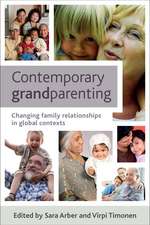Gene-Environment Interplay in Interpersonal Relationships across the Lifespan: Advances in Behavior Genetics, cartea 3
Editat de Briana N. Horwitz, Jenae M. Neiderhiseren Limba Engleză Hardback – 6 iul 2015
Included in the coverage:
- Gene-environment interplay in parenting young children.
- The sibling relationship as a source of shared environment.
- Gene-environment transactions in childhood and adolescent problematic peer relationships.
- Toward a developmentally sensitive and genetically informed perspective on popularity.
- Spouse, parent, and co-worker: roles and relationships in adulthood.
- The family system as a unit of clinical care: the role of genetic systems.
| Toate formatele și edițiile | Preț | Express |
|---|---|---|
| Paperback (1) | 388.13 lei 6-8 săpt. | |
| Springer – 15 oct 2016 | 388.13 lei 6-8 săpt. | |
| Hardback (1) | 395.47 lei 6-8 săpt. | |
| Springer – 6 iul 2015 | 395.47 lei 6-8 săpt. |
Preț: 395.47 lei
Nou
Puncte Express: 593
Preț estimativ în valută:
75.68€ • 78.72$ • 62.48£
75.68€ • 78.72$ • 62.48£
Carte tipărită la comandă
Livrare economică 14-28 aprilie
Preluare comenzi: 021 569.72.76
Specificații
ISBN-13: 9781493929221
ISBN-10: 1493929224
Pagini: 296
Ilustrații: XI, 281 p. 6 illus.
Dimensiuni: 155 x 235 x 20 mm
Greutate: 0.59 kg
Ediția:2015
Editura: Springer
Colecția Springer
Seria Advances in Behavior Genetics
Locul publicării:New York, NY, United States
ISBN-10: 1493929224
Pagini: 296
Ilustrații: XI, 281 p. 6 illus.
Dimensiuni: 155 x 235 x 20 mm
Greutate: 0.59 kg
Ediția:2015
Editura: Springer
Colecția Springer
Seria Advances in Behavior Genetics
Locul publicării:New York, NY, United States
Public țintă
ResearchCuprins
The sibling relationship as a source of shared environment.- Gene-environment transitions in childhood and adolescence problematic peer relationships.- Gene-environment processes in adolescent family relationships.- Toward a developmentally sensitive and genetically informed perspective on popularity.- Spouse, parent, and co-workers: Relationships and roles during adulthood.- Interpersonal relationships in late adulthood.- The family system as a unit of clinical care: The role of genetic systems.
Notă biografică
Briana N. Horwitz, Ph.D., is an assistant professor in the Department of Psychology at California State University, Fullerton. She completed her undergraduate studies at The University of California, Los Angeles and her doctoral studies at the University of California, Irvine. She also served as a postdoctoral fellow under the advisement of Dr. Neiderhiser at the Pennsylvania State University. Her research interests are in understanding the sources and directions of the associations among interpersonal relationships and functioning across the lifespan and more specifically to investigate how genetic and environmental factors explain these associations.
Jenae M. Neiderhiser, Ph.D., is Liberal Arts Research Professor in the Department of Psychology and Professor of Human Development and Family Studies at The Pennsylvania State University. She completed her undergraduate studies in Psychology at The University of Pittsburgh and her doctoral studies in Human Development and Family Studies at The Pennsylvania State University. She is currently serving as Associate Editor for the Journal of Research on Adolescence and is on the editorial board of Development and Psychopathology and Child Development. She is also serving as a board member for the Society for Prevention Research. Her research interests are in understanding the interplay between genes and environment throughout the lifespan. The environmental influences that she has examined most closely are interpersonal relationships-including parent-child, spouse, sibling, and peer relationships. Examining how individuals influence their environments, in part because of their genetically-influenced characteristics, has long been a focus on her work.
Jenae M. Neiderhiser, Ph.D., is Liberal Arts Research Professor in the Department of Psychology and Professor of Human Development and Family Studies at The Pennsylvania State University. She completed her undergraduate studies in Psychology at The University of Pittsburgh and her doctoral studies in Human Development and Family Studies at The Pennsylvania State University. She is currently serving as Associate Editor for the Journal of Research on Adolescence and is on the editorial board of Development and Psychopathology and Child Development. She is also serving as a board member for the Society for Prevention Research. Her research interests are in understanding the interplay between genes and environment throughout the lifespan. The environmental influences that she has examined most closely are interpersonal relationships-including parent-child, spouse, sibling, and peer relationships. Examining how individuals influence their environments, in part because of their genetically-influenced characteristics, has long been a focus on her work.
Textul de pe ultima copertă
Intriguing new findings on how genes and environments work together through different stages of life take the spotlight in this significant collection. Studies from infancy to late adulthood show both forces as shaping individuals' relationships within family and non-family contexts, and examine how these relationships, in turn, continue to shape the individual. Transitional periods, in which individuals become more autonomous and relationships and personal identities become more complicated, receive special emphasis. In addition, chapters shed light on the extent to which the quantity and quality of genetic and environmental influence may shift across and even within life stages.
Included in the coverage:
Behavioral geneticists, clinical psychologists, and family therapists will find in Gene-Environment Interplay in Interpersonal Relationships across the Lifespan a window into current thinking on the subject, new perspectives for understanding clients and cases, and ideas for further study.
Included in the coverage:
- Gene-environment interplay in parenting young children.
- The sibling relationship as a source of shared environment.
- Gene-environment transactions in childhood and adolescent problematic peer relationships.
- Toward a developmentally sensitive and genetically informed perspective on popularity.
- Spouse, parent, and co-worker: roles and relationships in adulthood.
- The family system as a unit of clinical care: the role of genetic systems.
Behavioral geneticists, clinical psychologists, and family therapists will find in Gene-Environment Interplay in Interpersonal Relationships across the Lifespan a window into current thinking on the subject, new perspectives for understanding clients and cases, and ideas for further study.
Caracteristici
Provides unique focus on behavior genetic studies that examine interpersonal relationships across the lifespan Highlights novel genetically informed designs such as the Children of Twins Design, the Extended Children of Twins Design, and the prospective adoption design Concludes with discussion of implications of preventive interventions, as well as how behavioral genetics and intervention science can work together? Includes supplementary material: sn.pub/extras

















